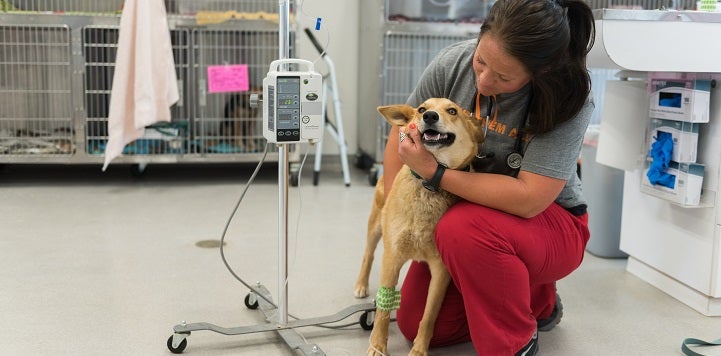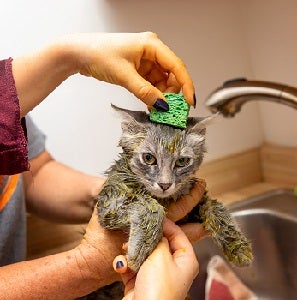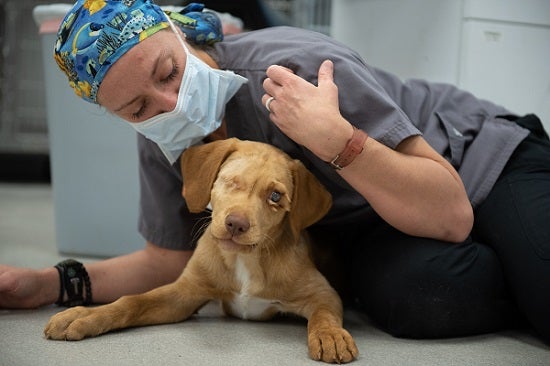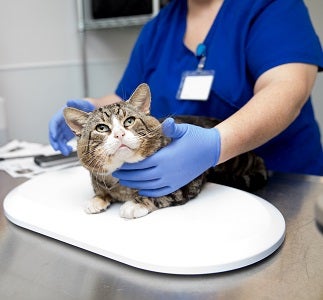
Making the jump from private practice to shelter medicine
Conference panelists share tips for attracting vet candidates to the field
We know all about the veterinary crisis that exists in multiple industries today. So, it was no surprise that a panel on “How to recruit, develop and support shelter vets” presented at the recent Best Friends National Conference drew a sizable and engaged audience. What was surprising, however, was that more than a few members of that audience weren’t aware of the level of competition there is to fill shelter vet positions today.
“When I mentioned at the conference how much competition there is for vets, people were startled,” says panel member Jennifer Federico, DVM, animal services director for Wake County Animal Center in Raleigh, North Carolina. “I don't think people realized how many shelter jobs are out there, much less how many private practice and corporate positions are available.”
As an example, she does a quick search while we chat and finds more than 5,000 veterinary jobs listed on the American Veterinary Medical Association job website; roughly 200 of those in shelters.
If veterinary candidates looking at those listings are anything like Jennifer and her fellow panelists, chances are they didn’t consider going into shelter medicine during school or in the early part of their careers. That means thousands of potential candidates may not even be looking at those 200 job opportunities in our industry!
There are a lot of reasons why that’s so. We’ve talked about how the veterinary field is working on some long-term solutions to the vet shortage, and shelter medicine is becoming its own specialty. In the meantime, however, Jennifer and fellow panelist Aimee Dalrymple, DVM, MS, strongly believe animal welfare organizations can impact the field today by educating veterinarians about why shelter medicine is a fulfilling pathway that more of them should be considering.
A bit of background
Jennifer and Aimee were like many vet students in that they never even considered preparing for a shelter or rescue vet position.
“There was no discussion of shelter medicine at my school,” says Aimee, who works as a contract and relief vet for several shelters in the Boston area. “Dogs came in from the local shelter for spay/neuter and although they went back to the facility, most of them were euthanized for space. So, I thought the only things shelter vets did were euthanasia and spay/neuter surgeries.”
 She also thought all jobs in animal rescue were volunteer, not paid positions. Then she found a sticky note on the counter of the private practice where she worked.
She also thought all jobs in animal rescue were volunteer, not paid positions. Then she found a sticky note on the counter of the private practice where she worked.
“It was from a rescue looking to actually hire a veterinarian, and that’s the entire reason I picked it up,” says Aimee. “I ended up working with several progressive rescue organizations, and they were the ones who introduced me to practices like pediatric spays and ear-tipping feral cats.”
As Aimee worked more on trap-neuter-return, she felt the need to brush up on her surgery skills. She attended a community cat management weeklong course at the University of Florida (UF) and was pleasantly surprised to discover an entirely new approach.
“I didn’t really even like surgery very much,” says Aimee, who ended up loving working with rescue animals so much that she completed a master’s degree and is now an adjunct assistant professor at University of Florida’s online Shelter Medicine program. “But the UF course showed me a new way to do spay/neuter procedures that was not just faster, it was honestly more fun.”
Jennifer not only didn’t consider shelter medicine, but she was also not planning to work with companion animals. Her schooling focused on equine medicine, and once she graduated she worked in corporate small animal practice for about three years.
“I didn't enjoy it, and I quit without having another job even lined up,” she says. “I was considering going back to school for a PhD when I stumbled upon a job offer from a municipal shelter.
They told me that they would be my worst client ever because they had too many animals and no money. They really set me up for success, though, and it turned out to be a great fit.”
Some notes about common misconceptions
Sadly, the misconceptions Jennifer and Aimee had before they started working in shelters and with rescues are still quite common among vets.
“Many still think shelter medicine is cutting corners and not doing a good job,” Aimee says. “One of my former bosses thought shelters must not use sterile instruments or they wouldn’t be able to do surgeries for such little money!”
Animal welfare organizations can dispel such ideas within their search for vet candidates. While it’s important to put out a competitive salary and benefits package, consider sign-on bonuses, reimburse for continuing education and memberships, and time the search for recently graduated vets in the spring, there are other components to include in a job description.

Make it clear that your shelter has high standards of care and does more than “just euthanasia and spay/neuter.” Vets who are burned out on talking about fleas and ticks might pick up on information about the common type of work vets will do at your organization.
Include your intake and outcomes data (especially if you have a high save rate) and include details about specialized programs like neonatal foster support or medically supported behavior programs. If you just added state-of-the-art radiographic equipment or have the capability to do dentals, say so. Above all, make it clear that your organization sees the shelter vet as an intrinsic part of the management team who also has the last word on medical decisions.
Jennifer and Aimee also stress the need to reach beyond a typical pool of candidates.
“Our most recent hire is a retired vet who had been in practice for 25 years, built three practices from the ground up and sold them,” Jennifer says. “He also felt that the profession had been good for him and wanted to give back. He has no shelter background whatsoever, but as our second vet he can do all of the medicine and surgery that we need.”
If your organization hasn’t explored sharing a vet with other shelters or even private practice vets in the area, you should. You can also consider holding an open house so that you can really give candidates a clear picture of what you have to offer. And don’t forget word of mouth.
“Honestly, I've gotten all my jobs through word of mouth and networking,” Aimee says. “Every conference, every conversation is an opportunity to spread the word.”
Always remember to take care of your staff
 Since many vets have a certain image in mind when they think about shelters, the job description or in-person visit is an ideal time to talk about the kind of supportive environment your organization fosters.
Since many vets have a certain image in mind when they think about shelters, the job description or in-person visit is an ideal time to talk about the kind of supportive environment your organization fosters.
“It’s unnerving to be working alone where in private practice you normally have other vets to bounce things off,” Jennifer says. “But over the years I found that shelter medicine is collaborative. People help each other out and there are so many resources online, so make sure that private practice candidates know that.”
Support also includes consideration of your vet’s physical and mental health.
“It’s the director’s job to make sure work-life balance happens, at least in terms of requiring lunch breaks and allowing only minimal overtime,” Aimee says. “If vets aren’t required to do on-call work, enforce that.
“We've been trained to just keep going, which leads to injuries like carpal tunnel and has a detrimental effect on our mental health,” she adds. “If you burn the vet out, eventually you're not going to have one.”
Unlike most roles in a shelter where you can cross-train other people, there isn't anyone else who can do the veterinarian’s job. One exception is euthanasia, and Aimee notes that is one medical task that should be spread among staff – if not removed from the vet’s requirements entirely.
Making sure vets are involved in good outcomes and gratitude from the public goes a long way to counteracting the negatives that can come with shelter work.
“We don't always see or hear about the good stuff; we often are only presented with the problems,” Aimee says. “We treasure getting a card or note from someone about how we helped the animal they adopted, and a lot of us keep these for years. Whenever you can involve us in the good outcomes that really means a lot.”
Finally, ask vets like Jennifer and Aimee to share what caused them to try out shelter medicine, as well as what keeps them there.
“I just really enjoy the people who do shelter and rescue, and find the specialty extremely rewarding,” Jennifer says. “It’s a passion-driven area of practice and you meet cool people. Shelters offer lots of opportunities to help a new demographic of animals and people, too.”
“That's part of why I enjoy my work; I can help where it’s really needed,” Aimee says. “And as I learned from personal experience, if you're willing to try something new, it can surprise you. You may end up really loving it.”

Liz Finch
Senior Writer
Best Friends Network
If you enjoyed this program spotlight, you can find our complete catalog of spotlights here.